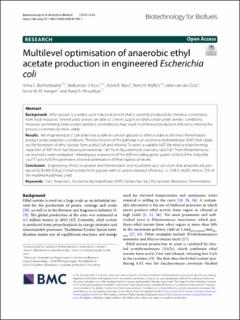| dc.contributor.author | Bohnenkamp, Anna C. | |
| dc.contributor.author | Kruis, Aleksander J. | |
| dc.contributor.author | Mars, Astrid E. | |
| dc.contributor.author | Wijffels, Rene Hubertus | |
| dc.contributor.author | van der Oost, John | |
| dc.contributor.author | Kengen, Servé W. M. | |
| dc.contributor.author | Weusthuis, Ruud A. | |
| dc.date.accessioned | 2021-02-25T12:53:14Z | |
| dc.date.available | 2021-02-25T12:53:14Z | |
| dc.date.created | 2021-02-15T11:30:24Z | |
| dc.date.issued | 2020 | |
| dc.identifier.citation | Bohnenkamp, A. C., Kruis, A. J., Mars, A. E., Wijffels, R. H., van der Oost, J., Kengen, S. W. M. & Weusthuis, R. A. (2020). Multilevel optimisation of anaerobic ethyl acetate production in engineered Escherichia coli. Biotechnology for Biofuels, 13: 65. doi: | en_US |
| dc.identifier.issn | 1754-6834 | |
| dc.identifier.uri | https://hdl.handle.net/11250/2730433 | |
| dc.description.abstract | Background: Ethyl acetate is a widely used industrial solvent that is currently produced by chemical conversions from fossil resources. Several yeast species are able to convert sugars to ethyl acetate under aerobic conditions. However, performing ethyl acetate synthesis anaerobically may result in enhanced production efficiency, making the process economically more viable. Results: We engineered an E. coli strain that is able to convert glucose to ethyl acetate as the main fermentation product under anaerobic conditions. The key enzyme of the pathway is an alcohol acetyltransferase (AAT) that catalyses the formation of ethyl acetate from acetyl-CoA and ethanol. To select a suitable AAT, the ethyl acetate-forming capacities of Atf1 from Saccharomyces cerevisiae, Eat1 from Kluyveromyces marxianus and Eat1 from Wickerhamomyces anomalus were compared. Heterologous expression of the AAT-encoding genes under control of the inducible LacI/T7 and XylS/Pm promoters allowed optimisation of their expression levels. Conclusion: Engineering efforts on protein and fermentation level resulted in an E. coli strain that anaerobically produced 42.8 mM (3.8 g/L) ethyl acetate from glucose with an unprecedented efficiency, i.e. 0.48 C-mol/C-mol or 72% of the maximum pathway yield. | en_US |
| dc.language.iso | eng | en_US |
| dc.publisher | BioMed Central | en_US |
| dc.rights | Navngivelse 4.0 Internasjonal | * |
| dc.rights.uri | http://creativecommons.org/licenses/by/4.0/deed.no | * |
| dc.title | Multilevel optimisation of anaerobic ethyl acetate production in engineered Escherichia coli | en_US |
| dc.type | Peer reviewed | en_US |
| dc.type | Journal article | en_US |
| dc.description.version | publishedVersion | en_US |
| dc.rights.holder | © 2020 The Author(s) | en_US |
| dc.subject.nsi | VDP::Teknologi: 500::Bioteknologi: 590 | en_US |
| dc.subject.nsi | VDP::Matematikk og Naturvitenskap: 400::Basale biofag: 470::Biokjemi: 476 | en_US |
| dc.subject.nsi | VDP::Matematikk og Naturvitenskap: 400::Basale biofag: 470::Molekylærbiologi: 473 | en_US |
| dc.subject.nsi | VDP::Matematikk og Naturvitenskap: 400::Basale biofag: 470::Generell mikrobiologi: 472 | en_US |
| dc.source.pagenumber | 14 | en_US |
| dc.source.volume | 13 | en_US |
| dc.source.journal | Biotechnology for Biofuels | en_US |
| dc.identifier.doi | 10.1186/s13068-020-01703-1 | |
| dc.identifier.cristin | 1889798 | |
| dc.source.articlenumber | 65 | en_US |

